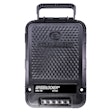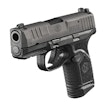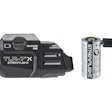The purpose of this article is to pass on a few observations and suggestions that might help law enforcement officers and their employing agencies improve firearms training, especially for those officers who find it difficult to qualify with their issued firearms.
For those of us who like to shoot, any chance to qualify with free ammunition is something to look forward to. But some officers do not enjoy qualifying. For them the process is agonizing and stress inducing as they try a second or even a third time to achieve a passing score.
I knew political correctness was getting out of hand and we were getting soft as a nation the day I went to the range to qualify and the firearms instructors from my agency, the U.S. Customs Service, stopped assigning a numerical rating to each target that was scored. Instead, they put a big "P" on the targets that "passed." As it was explained to me at that time, the agency was no longer scoring targets numerically and would no longer designate the better shooters with well-earned titles such as "Distinguished Expert" or "Distinguished Marksman" because it made those who were unable to achieve such high scores feel bad.
While I do not wish to embarrass law enforcement officers who barely qualify or fail to qualify I see the movement away from using a numerical firearms qualification scoring system that identified the better shooters as an Expert Marksman, a Distinguished Marksman, or a simple Marksman as being a big mistake.
Simply put, an officer's failure to achieve a passing score should not detract from someone who deserves or warrants special recognition because he or she excels in firearms proficiency. Instead, agencies should motivate poor shots to do better. After all, law enforcement officers carry firearms for a reason.
When you take away the positive reinforcement that goes along with being a high achiever you make getting the lowest passing grade the high water mark for success for those who need to apply themselves. You know what happens then. When you aim for a 100 percent on a test, you may end up with a score of 95, a 90, or even an 85. But when you hunch your shoulders like a defeatist as you enter the classroom and pray for a 70, you are more likely to get a 60 or 50.
Why We Fail
There are many reasons why some officers have a hard time qualifying with their issued weapons. Some of them are just plain bad shots and they haven't made an effort to improve. Others may be forced to use the wrong gun and maybe even the wrong ammo.
I believe that one of the most important factors in handgun training is matching the gun and the ammo to the shooter. Some agencies insist on issuing the same gun to every officer, but people are different. And a full-sized .45 that's perfect for one officer may be way too big for another.
Fortunately, numerous gun makers now offer adjustable backstraps for their pistol grips. If your agency is smart enough to use pistols that can be fitted to its officers, then it should take the time to make sure that each gun is modified to best fit each officer's hand.
Another reason that some officers fail to qualify despite their best efforts is that the agency forces them to use a gun that is too powerful. It's all well and fine to say that the .45 ACP or .40 S&W offers greater stopping power than a 9mm, but stopping power is useless unless the rounds hit the target. This is why I believe one of the primary failings of law enforcement firearms training is realizing that some officers would be better off with a less powerful gun. I suggest that law enforcement agencies obsessed with issuing one make or brand of firearm allow sworn personnel to carry a softer shooting 9mm pistol from the same manufacturer.
Less powerful ammunition is another option for officers who have a felt recoil issue. This means if you issue .40 S&W caliber pistols, you should allow your sworn personnel to use a softer shooting 180-grain bullet instead of a 155-grain round or a standard velocity 230-grain .45 ACP round instead of a Plus P rated 230-grain .45 ACP bullet. Even changing the brand of ammunition that you use can sometimes help reduce the problem of dealing with more severe recoil.
Agency Solutions
Agencies should consider letting sworn personnel carry a completely different handgun. The Maricopa County (Ariz.) Sheriff's Office and the Pima County (Ariz.) Sheriff's Department are examples of law enforcement agencies that have flexible firearms policies. Their sworn personnel are allowed to carry any gun from a rather long list of approved makes and models in various approved calibers. This flexibility allows deputies to choose the handguns and the calibers that they shoot the best for on duty, off duty, backup, and undercover use.
An excellent example of the benefits of being flexible about the firearms that you issue sworn personnel involves a very good friend of mine who worked for a Massachusetts police department.
For some time now, his department has issued a lightweight service pistol in .40 S&W caliber to all its officers. As the story was related to me, one particular officer in this department had difficulty using the department-issued pistol in .40 S&W caliber.
After exhausting all possible options to help this officer qualify, a lieutenant stepped in and handed the officer, who has small hands, his personally owned SIG 239 that is chambered in the same caliber as the department-issued pistols. Presto! The problem was solved and a very progressive police lieutenant authorized the purchase of one SIG 239 in .40 S&W caliber for this officer.
By doing so that lieutenant managed to keep a valuable asset employed in his police department. This solution is much better than seeing a good cop get forced out because he or she is unable to shoot a big pistol in .40 S&W caliber with enough precision to maintain minimum state standards.
Another example worth repeating involves the Cochise County Sheriff's Office (CCSO) in southern Arizona. According to Dep. Commander Ken Buckner, the department currently qualifies 95 commissioned gun-carrying personnel, including deputies and a smaller number of detention officers. Its sworn personnel qualify once a year on a daytime course and once a year on a nighttime firearms qualification course that is based on a passing score of 220 points out of a possible 250.
The CCSO averages about 10 qualification failures on the first attempt but usually all but two tend to qualify after some remedial training. The remaining two generally qualify by the third attempt. These are not bad stats when you consider that other law enforcement agencies have significantly higher percentages of sworn personnel who barely qualify or are unable to qualify.
It should also be noted that the CCSO makes its sworn personnel qualify with a minimum passing score of 220 points, even though Arizona P.O.S.T. standards require law enforcement officers to qualify with a passing score of 210. When you factor this into the equation, the percentage of poor shots in the CCSO is even smaller than other agencies.
The CCSO issues full size all steel Colt and Springfield Armory 1911s in .45 ACP, and I believe this is one of the reasons why its officers shoot so well. These pistols are very accurate and comfortable to shoot. I have also personally tested various Colt, Springfield Armory, Smith & Wesson, and Kimber 1911s in .45 ACP and found them to be flawlessly reliable, comfortable to shoot, and incredibly accurate. As you can guess, I am a big fan of the 1911 as a duty gun.
What You Can Do
Much of what we've talked about so far in this article has involved what agencies can do to improve qualification ratios. However, there are also some little things that individual officers can do to give themselves a qualification edge.
I advocate the use of shooting gloves with the finger covering removed. Well made shooting gloves can reduce the painful effects of recoil that can be associated with shooting certain handguns in substantial calibers that use snappy ammunition. Gloves will also provide you with a better purchase or grip on your pistol, which should generally improve your shooting skills.
If your agency gives you an option, choose ammunition that you can shoot well. I highly recommend the use of standard velocity (non Plus P) 9mm Federal 147-grain and 124-grain training ammunition as well as 9mm 147-grain and 124-grain Federal and Winchester hollow-point ammunition as an alternative to more snappy calibers. I also prefer standard velocity 180-grain .40 S&W Federal and Speer FMJ ammunition as well as 180-grain Federal and Winchester hollow-point ammunition over the 155-grain FMJ and hollow-point rounds.
Some agencies like to issue Plus P .45 ACP ammunition for improved penetration. However, if certain sworn personnel are unable to qualify I see no reason why a department cannot issue .45 ACP training and service ammunition that is softer shooting and yet still effective.
And when possible, choose the right gun. Some of you might be amazed at the differences between two different makes of firearms in the same caliber.
I know from experience that you can take two pistols made by different manufacturers that are chambered in the same caliber and have one pistol display more felt recoil while the other pistol is softer shooting. One test that I conducted was with a Heckler & Koch USP Compact in .40 S&W and a SIG 229 in .40 S&W using 155-grain issued Federal Classic .40 S&W caliber ammunition. When both pistols were fired the SIG 229 proved to be a bit softer shooting.
During another test I found the SIG 229 as well as the H&K P2000 Compact and a Heckler & Koch P2000 SK Sub Compact in .357 SIG to be incredibly soft shooting when compared to other makes and models. You can even see this phenomenon in pistols of the same make. To me, the SIG 220 Carry Model with a Single Action Only, DA/SA and a DAK trigger system is softer shooting than a full size SIG 220 in .45 ACP. Likewise, I have found the Smith & Wesson Military & Police Mid Size 45 and the Smith & Wesson Military & Police Compact Pistol in .45 ACP to be softer shooting than the full size Military & Police Pistol in .45 ACP. The SIG 220 Compact in .45 ACP is also very soft shooting.
Another option for reducing felt recoil is to use a ported or compensated Glock. I have arthritic hands that make it virtually impossible for me to comfortably fire a Glock 23 in .40 S&W, but I have no difficulty shooting my Glock 23C. The Maricopa County Sheriff's Office has done extensive testing of ported Glock pistols and found them to be officially safe to use on or off duty in all issued calibers.
In the end, you have to be the one to look in the mirror if you are involved in an on- or off-duty use of deadly force situation and your bullets fail to hit the mark when your intervention could mean the difference between someone living or dying. Consequently, it pays to do everything humanly possible to become proficient with the firearms that you carry on and off duty. Remember, in a gunfight there is no silver medal for second place. Only winners get to go home after you use authorized deadly force with a firearm.
Nick Jacobellis is a medically retired U.S. Customs Agent and former New York police officer who was physically disabled in the line of duty while working undercover as a federal agent.
FOR MORE INFORMATION














